| Back Number | No.07 2005/01/19 | |||
| News | Outline of the Transport System within the Venues Becomes Firm |  |
||
| Pavilions : Global House | ||||
| Interview | N. N. Khanna (India) Indian Commissioner General of EXPO 2005 Aichi, Japan |
|||
| Column | Nature’s Wisdom | |||
![]()
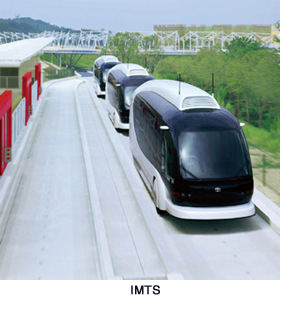 There are environmentally-friendly considerations being made for the modes
of transport at EXPO 2005 Aichi, Japan, which is a world exposition with the
theme of “Nature’s Wisdom.” The outline of these transportation
means became firm and was announced recently.
There are environmentally-friendly considerations being made for the modes
of transport at EXPO 2005 Aichi, Japan, which is a world exposition with the
theme of “Nature’s Wisdom.” The outline of these transportation
means became firm and was announced recently. On the Global Loop in the Nagakute Area will be battery-operated Global Tram. Consisting of a traction car and two passenger cars, the Global Tram will transport 52 people and two wheelchairs at one time. It will travel at a speed of about five kilometers per hour. There will be four stops within the Global Loop. There will be a charge for boarding the Global Tram, which will travel about halfway around the Global Loop per each round (the distance of two tram stops) but passengers will be able to board or disembark at mid-way points. Other means of transport within the Nagakute Area will include the Intelligent Multimode Transport System (IMTS) and the Kiccoro Gondola (boarding fee charged for both modes of transportation). The IMTS will consist of uncoupled driverless busses that will drive in formations of three while sensing the magnetic markers buried along the exclusive route. It utilizes the latest in IT technology, and the busses will communicate between each other so that a bus that follows another will maintain a designated distance. A system to prevent collisions will also be in operation. The maximum speed of the IMTS, equipped with a clean compressed natural gas (CNG) engine, will be 30 km per hour. The IMTS will transport close to 20,000 people per day. |
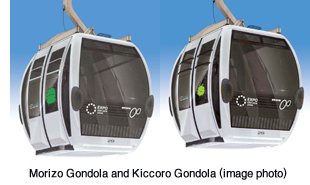 The Kiccoro Gondola will link the north and south ends of the Nagakute
area (about one kilometer in length) in about four minutes. The boarding
capacity of each gondola is eight people, and it will travel at a speed
of about 18 kilometers per hour. It will be able to transport about 2,400
people each way per hour, and it will also be possible to load one wheelchair.
There will be 47 such gondolas in operation.
The Kiccoro Gondola will link the north and south ends of the Nagakute
area (about one kilometer in length) in about four minutes. The boarding
capacity of each gondola is eight people, and it will travel at a speed
of about 18 kilometers per hour. It will be able to transport about 2,400
people each way per hour, and it will also be possible to load one wheelchair.
There will be 47 such gondolas in operation.A link between the Nagakute Area and the Seto Area is the Morizo Gondola and the Fuel Cell Hybrid Bus. These two modes of transport, which are both free of charge, will help create a sense of oneness and shorten the distance between the two areas. The Morizo Gondola will tie the two kilometers between Nagakute and Seto in about eight minutes. Traveling at a speed of about 21 kilometers, the eight-passenger gondola has the capacity to transport 1,800 people each way per hour. There will be 54 such gondolas in operation. The Fuel Cell Hybrid Busses traveling between the two areas will be powered by fuel cells that will utilize high-pressure hydrogen gas as well as nickel-metal-hydride batteries. They will travel the approximately 4.4 kilometers between the two areas on public roads. The body of these busses is an improvement on the large busses that run on regular routes. Passenger capacity is 65. Utilizing hybrid technology, the busses will emit neither any carbon dioxide nor harmful substances. Water is the only thing that will be emitted. Another unique feature being tested at the Nagakute Area of EXPO 2005 are bicycle taxis that will consist of electrically-assisted bicycles equipped with passenger seating fixtures. As you can see, all of the modes of transport at EXPO 2005 are environmentally-friendly cutting edge systems. These ways of traveling within or between areas should, in themselves, become ways of enjoying this world exposition. |
![]()
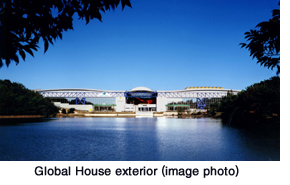 The Global House is the theme pavilion planned and operated by the Japan
Association for the 2005 World Exposition. Here, visitors will be able
to experience “Nature’s Wisdom,” the theme of EXPO 2005 Aichi,
Japan and imagine what the world society will be like in the future.
The Global House is the theme pavilion planned and operated by the Japan
Association for the 2005 World Exposition. Here, visitors will be able
to experience “Nature’s Wisdom,” the theme of EXPO 2005 Aichi,
Japan and imagine what the world society will be like in the future.The pavilion will consist of three zones: the Blue Hall, Orange Hall, and the Mammoth Lab where the frozen specimen of the Yukagir Mammoth, a centerpiece attraction of EXPO 2005, will be displayed. First, in the Blue Hall, is the Laser Dream Theater featuring one of the world’s largest seamless screens, a 2,005 inch or a screen about 50 meters wide and roughly 10 meters high. The adoption of laser - with its superior color purity - as the light source will enable the brilliant colors of the scenes of the Earth and humankind today that will be shown. |
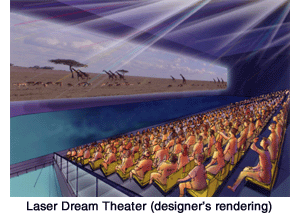 There is the Super High Vision Theater at the Orange Hall. Here, visitors
will experience the beauty of the Earth in which we live. It offers the
world’s first ultra-fine image that is 16 times clearer than Hi-Vision,
as well as a 22.2 channel three-dimensional sound system. You will be
able to undergo a virtual experience through magnificent panoramic images
and sounds of nature, etc. and feel as if you are really there.
There is the Super High Vision Theater at the Orange Hall. Here, visitors
will experience the beauty of the Earth in which we live. It offers the
world’s first ultra-fine image that is 16 times clearer than Hi-Vision,
as well as a 22.2 channel three-dimensional sound system. You will be
able to undergo a virtual experience through magnificent panoramic images
and sounds of nature, etc. and feel as if you are really there. As visitors exit the theater, they will move on to the Global Showcase. There will be displays that showcase humankind’s precious heritage and the results of cutting-edge research. They are divided into six themes tentatively named: “the day humans were born,” “the day mammoths died,” “the day cities were built,” “the day dreams came true,” “the day humans saw the earth from space,” and “the day that future began.” In “the day humans were born,” a replica of a 6 to 7 million year old skull of a hominid discovered in 2002 will be displayed. “The day humans saw the earth from space” will include exhibits of a model of the latest planet probe spacecraft, footprints left on the moon by humankind, as well as a lunar rock. In “the day dreams came true,” visitors will take a virtual journey in a pitch-black room, with just sound of James Watt’s steam locomotive to guide them. |
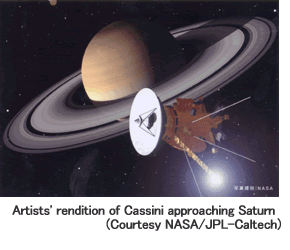 At Orange Hall, visitors will be handed the Aimulet GH, a credit-card
sized ultra-small voice guidance terminal that is 5 mm thick and weighs
only 28 grams. By pointing the Aimulet GH towards an exhibit, and then
pressing it against their ear, visitors will be able to listen to the
voice of navigators who will provide narrative that will stimulate your
imagination or explain the content of exhibits in Japanese or English.
Furthermore, a wireless IC tag will be used to analyze the flow of visitors
and to forecast congestion or to lighten congestion through visitor guidance.
At Orange Hall, visitors will be handed the Aimulet GH, a credit-card
sized ultra-small voice guidance terminal that is 5 mm thick and weighs
only 28 grams. By pointing the Aimulet GH towards an exhibit, and then
pressing it against their ear, visitors will be able to listen to the
voice of navigators who will provide narrative that will stimulate your
imagination or explain the content of exhibits in Japanese or English.
Furthermore, a wireless IC tag will be used to analyze the flow of visitors
and to forecast congestion or to lighten congestion through visitor guidance.
Finally, the Mammoth Lab will take visitors about 18,000 years back in time so that they can come face-to-face with the Yukagir Mammoth that has been unearthed from the permafrost of Siberia. Here, visitors will be able to view the head, leg and other parts of the mammoth that is being stored in a frozen state, as well as see the results of research on the mammoth. The Global House is a pavilion where visitors will be able to experience and imagine the world. What will you experience here, and what kind of a future will you imagine for the Earth? |
![]()
![]()
 |
|
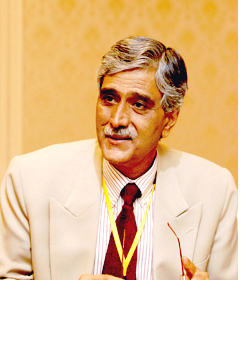 Japan has a tradition of Zen. You see art and nature in their most simple forms, and beauty comes from that simplicity. We have a similar view in India. Meanwhile, the simplest form of physical fitness in India is yoga. It is not performed with machines but rather through the body and mind. I think that this is a strand in common with the traditions of Japanese culture for achieving harmony between the mind and the body.
Japan has a tradition of Zen. You see art and nature in their most simple forms, and beauty comes from that simplicity. We have a similar view in India. Meanwhile, the simplest form of physical fitness in India is yoga. It is not performed with machines but rather through the body and mind. I think that this is a strand in common with the traditions of Japanese culture for achieving harmony between the mind and the body.The people of India live a life which is very close to nature. Because India has many things in common with Japan, I think it is easy for the people of India to understand the choice of “Nature’s Wisdom” as the theme of the World Exposition being held in Japan. The India Pavilion reflects this principle theme (Nature’s Wisdom) of EXPO 2005 Aichi, Japan as well as all the three sub-themes: “Nature’s Matrix,” the “Art of Life,” and “Development for Eco-Communities.” Of the three sub-themes, I am personally most interested in the Art of Life. The Art of Life is reflected in many ways in the Indian way of life. For example, India has a strong tradition of medical science based on natural materials, such as medicinal herbs, called Ayurveda. It is holistic medicine that draws out a person’s inherent, natural powers of healing. We also still use today not only synthetic chemical dyes and fabric but also natural dyes and fabric as materials for our clothing. While there are large industrial spinning looms, we maintain to date a traditional handmade manufacturing method that uses the charkha, a type of spinning wheel that was used by Mahatma Gandhi himself. The cloth that is weaved easily and inexpensively by hand using the charkha is very comfortable to wear; it is cool in summer and does not irritate the skin. We are going to try suggesting at EXPO 2005 a way of life that will promote the natural environment. There cannot be a happy, healthy, meaningful life for people unless there is harmony with nature. Humankind and nature are not in opposition; they are in harmony. I would like to express the appeal of EXPO 2005 as “the realization of the coexistence of humankind and nature in the beautiful prefecture of Aichi.” |
|
![]()
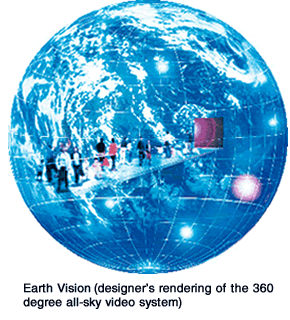 There are now only about two months until the opening of EXPO 2005 Aichi,
Japan. While preparations to welcome people from around the world continue
in Japan, we thought it might be appropriate at this time to reconfirm
what kind of an EXPO Japan would like to organize as host through the
theme, “Nature’s Wisdom,” or the superior mechanisms inherent
in nature, and what kind of a message it can disseminate to the world?
There are now only about two months until the opening of EXPO 2005 Aichi,
Japan. While preparations to welcome people from around the world continue
in Japan, we thought it might be appropriate at this time to reconfirm
what kind of an EXPO Japan would like to organize as host through the
theme, “Nature’s Wisdom,” or the superior mechanisms inherent
in nature, and what kind of a message it can disseminate to the world?
There are many issues that we are facing today - such as desertification and global warming - that have resulted from the 20th century that was symbolized by mass production and mass consumption. Through EXPO 2005 Aichi, Japan would like to raise these issues common to humankind for consideration, collect the wisdom of the world and aim to create a sustainable future for Earth in which there is harmony between humankind and nature. The key elements of the proposal by Japan, based on its own experiences, are: “Nature’s Wisdom,” “Science and Technology,” and the “Grand Intercultural Symphony.” Under conditions that included an insufficient amount of land for industrial use and poor mineral resources, Japan advanced industrial development while in harmony with nature and grew to become a country with the second largest GDP in the world. A rich culture and society were realized. The aforementioned three keys can be said to have supported such growth in Japan. The people of Japan have proactively been involved with nature through its tradition of an agricultural culture. They have actively utilized the blessings of nature in a sustainable way. Through this process, they gained a wealth of knowledge about nature and insight regarding its essence. Japan found it could learn from “Nature’s Wisdom.” A strong interest in “Science and Technology,” and an attitude to take it beyond industrial applications to proactively make new lifestyles a part of daily life; the “Grand Intercultural Symphony” through which Japan absorbed the wisdom of humankind through cultural exchanges with the world... by adapting these elements to its natural environment and culture, it made it possible for Japan to maintain its unique culture while also developing it into something new. |
|
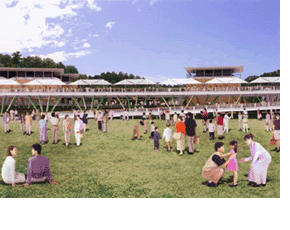 Japan’s cutting-edge imaging technologies, including Earth Vision with its
360 degree, all-sky vision cube, goes beyond knowledge to provide an experience
that shows how wonderful the Earth and nature is. Research that utilizes
scientific technology to unravel the mechanism of the Earth and nature
through precious human heritage collected from around the world - including
the remains of a mammoth recently unearthed in Russia from the permafrost
- will show the path that nature and humankind can take towards coexistence.
Japan’s cutting-edge imaging technologies, including Earth Vision with its
360 degree, all-sky vision cube, goes beyond knowledge to provide an experience
that shows how wonderful the Earth and nature is. Research that utilizes
scientific technology to unravel the mechanism of the Earth and nature
through precious human heritage collected from around the world - including
the remains of a mammoth recently unearthed in Russia from the permafrost
- will show the path that nature and humankind can take towards coexistence.
Furthermore, EXPO 2005 will show through concrete Japanese efforts, the major potential science and technology have in suppressing environmental destruction to a minimum. A Japanese custom is to sprinkle water in the garden and road around one’s house in order to seek cool air. This came together with photocatalytic technology, developed in Japan, to create a new type of air conditioning at the Japan Pavilion Nagakute. This is only one example of how the wisdom that humankind has developed over the years in its relationship with nature can be integrated with the latest scientific technology to develop into a new wisdom of the 21st century. Even the garbage generated from visitors will be turned into fuel at EXPO 2005. New energy systems will power all of the electrical needs of Japan Pavilion Nagakute , while fuel-cell powered busses that emit only water, will be operated between the two areas. These are just some of the examples of how the whole of EXPO 2005 will become an experiment, a simulation of a society of the near future in which nature and humankind will be able to coexist in harmony. In the Grand Intercultural Symphony, the traditions, cultures and lifestyles of more than 120 different countries as well as the wisdom of nature and humankind will come together, be exchanged and be integrated and develop into something new. EXPO 2005 will become a magnificent site for intercultural exchange, from which a concrete new lifestyle of humankind for the 21st century will arise. As host of the first world exposition to be held in the 21st century, Japan will be proud of offering an opportunity to develop a current that will help create a new future for humankind. It will await the arrival of visitors to EXPO 2005. |
|
| EXPO 2005 AICHI, JAPAN Newsletter | |
| To read past issues:Back Number | |
| Editor/Publisher: Japan Association for
the 2005 World Exposition Head Office: 1533-1 Ibaragabasama, Nagakute-cho Aichi 480-1101 Japan Nagoya Office: Nagoya Daiya II Bldg 4F, 3-15-1 Meieki Nakamura-ku, Nagoya, Aichi 450-0002 Japan Tokyo Office: Iino Bldg 8F, 2-1-1 Uchisaiwai-cho Chiyoda-ku, Tokyo 100-0011 Japan |
 |
© Japan Association for the 2005 World Exposition
